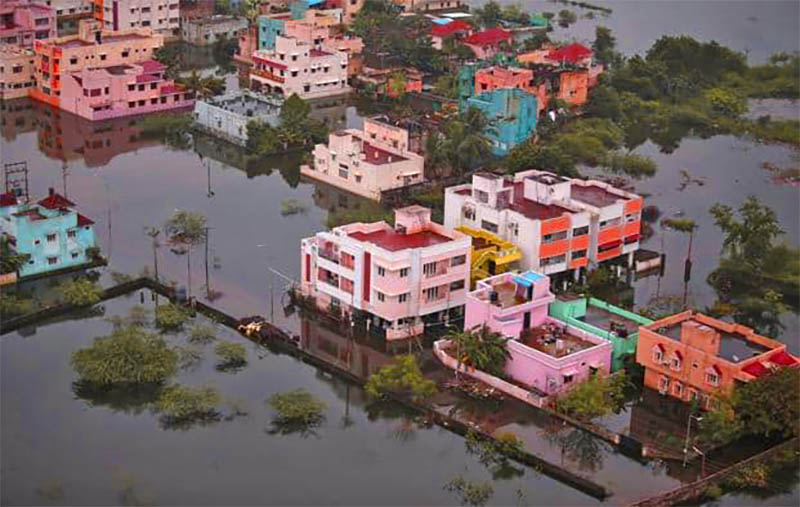Why Does Chennai Float During Cyclones?
Why Does Chennai Float During Cyclones?
5th July 2023

Introduction
Chennai, a vibrant coastal city in India, has been grappling with recurring flood events during cyclonic storms. In this article, we delve into the underlying reasons behind Chennai’s vulnerability to flooding in the wake of cyclones. By exploring the various factors at play, we can gain a better understanding of the situation and emphasize the importance of sustainable practices and infrastructure to mitigate such impacts.
Geography and Topography
Chennai’s geographical location, situated on the Coromandel Coast, exposes it to the wrath of cyclones originating in the Bay of Bengal. The city’s flat terrain and low-lying coastal areas make it susceptible to flooding. When cyclonic storms make landfall, the accompanying heavy rains and strong winds contribute to a rise in the sea level, resulting in storm surges. Chennai’s flat topography allows the storm surges to propagate inland, exacerbating the flooding situation.
Urbanization and Encroachment
Rapid urbanization and encroachment on water bodies and natural drainage channels have significantly impacted Chennai’s drainage system. As the city expanded, wetlands and natural floodplains were converted for construction purposes, disrupting the natural water flow and reducing the capacity to absorb excess rainfall. This urban sprawl has led to increased surface runoff, overwhelming the drainage infrastructure and exacerbating the flooding during cyclones.
Natural Barriers and River Systems
Chennai benefits from a natural protective shield in the form of the Pulicat Lake and the Ennore Creek. These water bodies act as natural buffers, absorbing a significant portion of the storm surge’s energy. The expansive wetlands and mangrove forests surrounding these areas further dissipate the force of the incoming waves, acting as a natural barrier against flooding. Moreover, the city is crisscrossed by several rivers and water channels, such as the Adyar and Cooum rivers. These waterways serve as drainage outlets, carrying excess rainwater away from the urban areas and into the sea, preventing waterlogging and reducing the risk of inundation.
Inadequate Infrastructure and Drainage Systems
Chennai’s drainage infrastructure has struggled to cope with the rapid pace of urban development. The existing stormwater drainage network was designed to handle average rainfall, leaving it ill-equipped to handle intense downpours associated with cyclonic storms. The inadequate capacity of the drainage system, coupled with poor maintenance and blockages caused by solid waste and debris, hinders the efficient flow of water, contributing to flooding in various parts of the city.
Climate Change and Changing Rainfall Patterns
Climate change has played a significant role in exacerbating the impacts of cyclones on Chennai. Changing weather patterns and rising global temperatures have resulted in increased intensity and frequency of rainfall events. This intensification of rainfall during cyclones overwhelms the drainage infrastructure, leading to widespread flooding. Adapting to these climate change effects and implementing resilient measures in urban planning and infrastructure design are crucial to mitigate future flood risks.
Sustainable Urban Planning and Infrastructure
Chennai’s ability to withstand cyclonic flooding also stems from its sustainable urban planning practices and robust infrastructure. Over the years, the city has made significant strides in implementing measures to manage stormwater effectively. The construction of reservoirs, retention ponds, and recharge wells helps capture and store rainwater, reducing the pressure on the drainage systems during heavy rainfall events. Additionally, the implementation of green infrastructure, such as rain gardens and permeable pavements, allows rainwater to infiltrate the soil, replenishing groundwater reserves and preventing runoff.
Conclusion
Chennai’s susceptibility to flooding during cyclones can be attributed to a combination of geographical factors, urbanization challenges, inadequate drainage systems, the presence of natural barriers, and the influence of climate change. Recognizing these factors is crucial for implementing sustainable urban planning, enhancing infrastructure resilience, and developing effective flood management strategies. By addressing these issues, Chennai can minimize the impacts of future cyclonic events, safeguarding the well-being of its residents, and fostering sustainable development.
RECOMMENDED

Jali, a traditional architectural element renowned for its beauty and functionality, has evolved...

Green audits are essential tools that provide a comprehensive assessment of an organization's environmental...

Daylighting is a strategic element in sustainable architecture, essential for reducing energy consumption and enhancing...